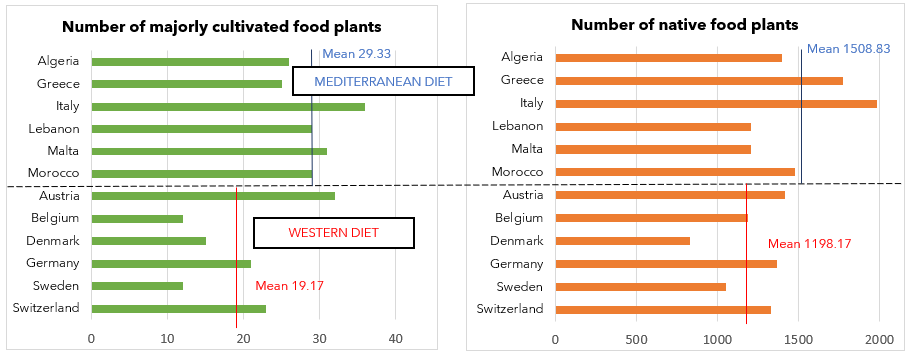The Mediterranean Diet Case: Biodiversity, a key requirement for food diversity and food security

Since the world population is steadily increasing, the question of how to feed people and provide adequate and healthy food to eliminate hunger and malnutrition constitutes a crucial social challenge. This constant population growth may be considered as an underlying threat to sustainable development. The Mediterranean diet has been widely recognized as a biodiversity and healthy nutrition resource to support sustainable development and food security. A recent work explored for the first time, biodiversity in terms of food plants species, subspecies, varieties, and races and addressed food plant diversity differences between the Mediterranean- and Western-type consumption patterns. A higher agricultural biodiversity in the Mediterranean region as well as a higher diversity in food plants species subspecies, varieties, and races was observed. The authors conclude that biodiversity could constitute a prerequisite for dietary diversity, and hence nutrition security.
Currently, feeding the steadily growing population and providing adequate and healthy food is a crucial social challenge (Van Dijk et al., 2021) as by 2050, the global population is expected to rise from 7.7 billion in 2019, to around 9.7 billion (Serra-Majem et al., 2020 ; Adam et al., 2021). According to estimates from the Food and Agriculture Organization (FAO), agro-food production will have to increase by almost 50% to accomplish consumers’ requirements and satisfy the increasing demand, especially for meat and processed meat products (FAO, 2017). Thus, this constant population growth may be an underlying threat to sustainable development because it stresses natural resources through overexploitation, intensive farming, and land fragmentation (Maja et al., 2021).
Besides, the current agro-food system is considered as a major driver of environmental degradation and climate change (Dudley et al., 2017 ; Sala et al., 2017), as intensified management practices together with the overexploitation of inputs may endanger the conservation of the terrestrial ecosystems and have severe impacts on biodiversity (Crenna et al., 2019 ; Henry et al., 2019). Therefore, dietary guidelines have to combine the health-nutrition aspect with the environmental aspect for providing food for all in a healthy and sustainable way. The traditional Mediterranean diet addresses both health and environmental issues because plant-based dietary patterns with low consumption of animal foods were proven to contribute to health maintenance and to help mitigate biodiversity degradation (Serra-Majem et al., 2020).
In light of biodiversity decline, a recent study (Mattas et al., 2023), funded by the EU BioValue Project, investigates for the first time, biodiversity in terms of food plants species, subspecies, varieties, and races and addresses food plant diversity differences between the MD and Western-type consumption patterns.
The mean of the majorly cultivated food plants in the Mediterranean diet was significantly higher than its counterpart in the Western diet
The number of majorly cultivated and native food plants (species, subspecies, varieties, and races) in selected countries was considered a proxy for the food plant diversity in dietary patterns. According to this work, Mediterranean countries had a higher average of both majorly cultivated (29.33 vs 19.17) and native food plants (1508.83 vs 1198.17) than the “Western diet” group.
Within the group Mediterranean countries, Italy had the most diverse cuisine in both majorly cultivated and native food plants compared to the rest countries of our sample, whereas Algeria and Greece, and Algeria, Lebanon, and Malta were ranked below-the-average in terms of diversity in majorly cultivated and native food plants, respectively. As regards Western countries, biodiversity in majorly cultivated food plants was lower in Belgium, Denmark, and Sweden compared to the other selected countries, whereas Denmark had the lowest average of native food plants (see figure 1).

With respect to the diversity in native food plants, no statistical difference was detected in the averages of the native food plants between the “MD” countries and the “Western diet” countries, indicating that this higher diversity in food plants observed in the Mediterranean countries seems to be attributed to crop utilization rather than crop availability.
Biodiversity could constitute a prerequisite for dietary diversity and hence nutrition security
Although biodiversity enables agricultural systems to evolve, the genetic diversification of food crops is continually decreasing: only 10% of the variety of cultivated crops in the past are still being grown in farm systems, with many local varieties being replaced by a small number of genetically improved nonnative varieties (Millstone et al., 2008).
Current food systems are under pressure to meet the increasing population’s nutrition demand. Dietary diversification is considered necessary for providing nutritional efficiency to consumers and helping them avoid micronutrient malnutrition resulting from monotonous diets (Nkonde et al., 2021). Although monocropping production systems have raised both food production and energy intake, reliance on a few major crops for population feeding has led to micronutrient deficiencies (Jones et al., 2017).
With the increasing demand for healthy and sustainable food, the adoption of the Mediterranean diet from new generations and its transmission to other geographic regions, it becomes crucial to sustainably managing plant genetic resources. The introduction of neglected and underutilized plant species (NUPs) in the agro-food systems would benefit both consumers and producers and would also contribute to biodiversity preservation (Libiad et al., 2021).
Diets should be approached in a broader way within the context of both agro-food and ecological systems
Due to the interlinkages between the agro-food system and the prevailing dietary patterns as showed in this analysis, the authors stressed that nutrition and diets should be approached with a broader and more integrated view. Adopting a more diverse diet in today’s modern society could support the establishment of a more biodiverse rural environment and mitigate the adverse effects of climate change in the long run.
Since biodiversity is strongly related with both human and environmental health, nutrition interventions, environmental preservation strategies and public health protection measures should involve multi-stakeholder partnership in order to make food systems sustainable along the entire food chain and also protect ecosystems as a whole.
Strengthening agricultural practices to conform with sustainable agroecosystem practices protects the right of all to have access to nutritious, adequate, and affordable food, while living within environmentally healthy and safe places.
Based on: Mattas K, et al. Assessing the Interlinkage between Biodiversity and Diet through the Mediterranean Diet Case. Adv Nutr. 2023 May;14(3):570-582.
- Dietary food choices are determinant not only for our health but also for the health of our ecosystems.
- Compared with Western-type dietary patterns, a higher agricultural biodiversity was underlined in the Mediterranean region.
- A higher diversity in food plants species, subspecies, varieties, and races was also observed in the Mediterranean diet compared with Western-type dietary patterns.
- This higher food plant diversity in the Mediterranean diet pattern seems to be more strongly associated with crop utilization rather than food plant availability in the Mediterranean region.
- Biodiversity could constitute a prerequisite for dietary diversity, and therefore nutrition security.
